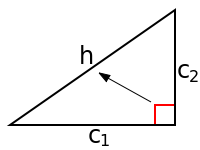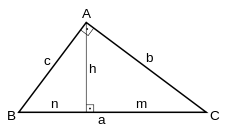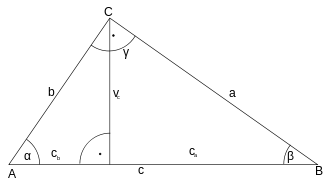Hypotenuse

In geometry, a hypotenuse is the longest side of a right-angled triangle, the side opposite of the right angle. The length of the hypotenuse of a right triangle can be found using the Pythagorean theorem, which states that the square of the length of the hypotenuse equals the sum of the squares of the lengths of the other two sides. For example, if one of the other sides has a length of 3 (when squared, 9) and the other has a length of 4 (when squared, 16), then their squares add up to 25. The length of the hypotenuse is the square root of 25, that is, 5.
Etymology
| Look up ὑποτείνουσα in Wiktionary, the free dictionary. |
The word hypotenuse is derived from Greek ἡ τὴν ὀρθὴν γωνίαν ὑποτείνουσα (sc. γραμμή or πλευρά), meaning "[side] subtending the right angle" (Apollodorus),[1] ὑποτείνουσα hupoteinousa being the feminine present active participle of the verb ὑποτείνω hupo-teinō "to stretch below, to subtend", from τείνω teinō "to stretch, extend". The nominalised participle, ἡ ὑποτείνουσα, was used for the hypotenuse of a triangle in the 4th century BC (attested in Plato, Timaeus 54d). The Greek term was loaned into Late Latin, as hypotēnūsa. Adoption as a learned Latinism used in modern languages dates to the 16th century.[2] The spelling in -e, as hypotenuse, is French in origin (Estienne de La Roche 1520).[3]
Calculating the hypotenuse

The length of the hypotenuse is calculated using the square root function implied by the Pythagorean theorem. Using the common notation that the length of the two legs of the triangle (the sides perpendicular to each other) are a and b and that of the hypotenuse is c, we have
The Pythagorean theorem, and hence this length, can also be derived from the law of cosines by observing that the angle opposite the hypotenuse is 90° and noting that its cosine is 0:
Many computer languages support the ISO C standard function hypot(x,y), which returns the value above. The function is designed not to fail where the straightforward calculation might overflow or underflow and can be slightly more accurate.
Some scientific calculators provide a function to convert from rectangular coordinates to polar coordinates. This gives both the length of the hypotenuse and the angle the hypotenuse makes with the base line (c1 above) at the same time when given x and y. The angle returned will normally be that given by atan2(y,x).
Properties

- The length of the hypotenuse equals the sum of the lengths of the orthographic projections of both catheti. And
- The square of the length of a cathetus equals the product of the lengths of its orthographic projection on the hypotenuse times the length of this.
- b² = a · m
- c² = a · n
- Also, the length of a cathetus b is the proportional mean between the lengths of its projection m and the hypotenuse a.
- a/b = b/m
- a/c = c/n
Trigonometric ratios
By means of trigonometric ratios, one can obtain the value of two acute angles, and , of the right triangle.
Given the length of the hypotenuse and of a cathetus , the ratio is:

The trigonometric inverse function is:
in which is the angle opposite the cathetus .
The adjacent angle of the catheti , will be = 90° –
One may also obtain the value of the angle by the equation:
in which is the other cathetus.
See also
Notes
- ↑ u(potei/nw, u(po/, tei/nw, pleura/. Liddell, Henry George; Scott, Robert; A Greek–English Lexicon at the Perseus Project
- ↑ Harper, Douglas. "hypotenuse". Online Etymology Dictionary. . E.g. Z. Lochner, Tractätlein, darinnen etliche schöne Exempel, auss der Geometria, etc., Nuremberg (1583), p. 64: "Qudarir den lengern Cathetum, als 24. und sein basis als 7. wirdt 576. unnd 49. addir die 2. Quadrat/ wirdt 625. unnd ist das Quadrat der Hypotenusa [...]"
- ↑ Estienne de La Roche, l'Arismetique (1520), fol. 221r (cited after TLFi).